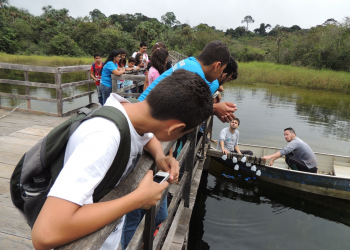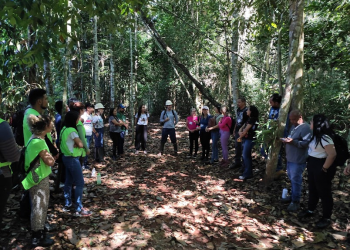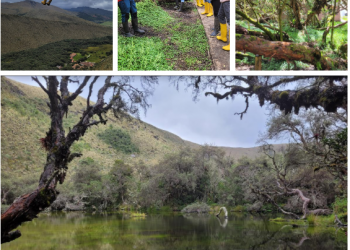Dentre os grupos animais, um dos que têm mais folclore e crendices associados são os herpetos (anfíbios e répteis). No caso especial de anfíbios, quem já não ouviu dizer do sapo que beijado vira príncipe; que xixi de sapo cega;que se a perereca grudar na sua pele só sai na próxima chuva, dentre outras peculiaridades míticas e anedóticas.São muitas e poderiam até compor uma postagem exclusiva. Entretanto hoje quero focar especialmente em uma.
Sou pesquisador e venho trabalhando com ecologia de anfíbios a, pelo menos, 13 anos. De forma corriqueira, tanto por amigos de longa data quanto por recém-conhecidos, sou questionado sobre uma dessas lendas da herpetologia que é nosso ponto de partida. A história é a seguinte:
“Se você deixar cair um sapo em uma panela de água fervente, é claro que ele tentará freneticamente sair o mais rápido possível. Mas se você colocá-lo suavemente em uma panela de água fria ou morna e ligar o fogo, ele flutuará lá bem placidamente. À medida que a água gradualmente aquece, o sapo afundará em um estupor tranquilo, exatamente como um de nós em um banho quente, e em pouco tempo, com um sorriso no rosto, se deixará ferver até a morte.”

Fontes: (A) http://thefrogthatjumpedout.blogspot.com/2013/07/more-and-more-boiling-frogs.html; (B) http://pt.swewe.net/word_show.htm/?721874_1&Quente_sapo_fervido; (C) http://blog.cajobportal.com/the-boiling-frog-syndrome-w-r-t-employee-feedback/; (D) https://thinkprogress.org/humans-are-not-like-slowly-boiling-frogs-we-are-like-slowly-boiling-brainless-frogs-62f673ff956c/
Quem de vocês já não escutou essa história, ou alguma variação dela, pelo menos uma vez? Pois é, eu muitas!!!! Foram tantas vezes que eu resolvi pesquisar não só a origem deste mito mas também, por outros motivos que explico com mais calma afrente, se tornaram uma pesquisa científica séria.
Para começar, esse mito é muito comum. Bem mais comum do que vocês imaginam, tanto que ele é descrito em outras culturas e encontrado em outras línguas (e.g. inglês, nepalês, japonês…).O mito é tão conhecido que inclusive serve de referência para esta charge que ironiza o presidente dos Estados Unidos Donald Trump sobre seu ceticismo com as mudanças climáticas.E, já que estamos falando de presidenciáveis dos EUA, lembro que uma versão otimista deste mito foi utilizada por Al Gore em seu documentário Uma Verdade inconveniente (An Inconvenient Truth – 2006).

Fonte:https://www.cartoonmovement.com/cartoon/37119
Fábulas, mitos e licenças poéticas a parte, o fato é: se um sapo “cai” dentro de uma panela com água fervendo ele morre na hora, não conseguirá fugir pulando. Se um sapo está em uma panela em que a água estiver gradativamente aumentando ele irá sair da água quando não estiver mais termicamente confortável. E ele consegue sentir isso.Não é necessário fazer este experimento para saber o resultado. Primeiro porque protocolos éticos de bem estar e experimentação animal não permitem. Segundo porque a ciência já acumulou informação suficiente para saber corretamente qual seria o resultado.
De fato, há uma publicação em alemão de 1872 que consegui rastrear que testou o mito:“Ueber die WirkungsehrallmäligerAenderungenthermischerReizeauf die Empfindungsnerven” por A. Heizemann. Minhas limitações na língua bárbara e sua provável grafia arcaica limitam minha total compreensão do texto, mas palavras como Frosches (= sapo) ao longo do texto sugerem que realmente a publicação se trata do tema.
 Tradução livre: Sobre o efeito de mudanças muito graduais de estímulos térmicos nos nervos sensoriais
Tradução livre: Sobre o efeito de mudanças muito graduais de estímulos térmicos nos nervos sensoriais
É fácil associar este mito com as mudanças climáticas globais que estamos passando. E essas mudanças não são mito não!!! Tanto que 99% dos cientistas acreditam que as mudanças climáticas observadas até o momento e as preocupantes previsões são resultado da ação humana.
No laboratório de limnologia estamos preocupados de como estas mudanças no clima podem afetar os organismos, suas comunidades e os processos ecossistêmicos. O projeto “Efeitos das mudanças climáticas no funcionamento dos ecossistemas aquáticos” abrange todas estas escalas e, além de muitos outros organismos aquáticos (e.g. zooplâncton e macroinvertebrados) utilizam anfíbios em sua forma larval – girinos. Nestes trabalhos usamos a temperatura como um estressor e mensuramos inúmeras variáveis resposta além da observação do comportamento dos organismos. O que posso adiantar-lhes é que os girinos não aceitam placidamente o aumento gradual da temperatura. Eles claramente mudam de comportamento tentado sair do aquário onde estão. Nossos protocolos não esperam a morte dos animais. Nem é necessário. Após uma mudança brusca de comportamento, os organismos cessam seus movimentos e são declarados ecologicamente mortos (por perderem sua função no ecossistema e estarem susceptíveis aos predadores) apesar de fisiologicamente vivos. Nós então os retiramos da água aquecida e o retornarmos para água a temperatura ideal até que se recupere totalmente e possa ser devolvido à natureza.
É muito importante que as pessoas entendam o que é verdade ou pura crendice sem fundamento. A conservação de espécies passa em grande parte de como o cidadão comum vê determinada espécie. Como biólogo e educador, procuro sempre valorar todas as espécies e evitar que qualquer desinformação as prejudique. Temos que fazer isso tanto pela biodiversidade em si como pelas funções que exercem no ecossistema. Conto com a ajuda de vocês nessa missão!
Como toda boa fábula, precisamos de uma “moral da história”. Bem, vamos lá… É fato que a água está aquecendo. Seremos como o sapo inerte do mito ou nos mexeremos para, no mínimo, tentar mudar esta situação?
Referências Boas:
Bernarde P.S. 2012. Anfíbios e Répteis: introdução ao estudo da herpetofauna brasileira. Anolis Books.
Sleight, C. 2012.Frog.Reaktion Books Ltd.
http://ourherpclass.blogspot.com.br/2013/04/boiling-frog-myth_3.html
https://en.wikipedia.org/wiki/Boiling_frog
Cooking frog yes, but to swallow not*: Climate change and amphibians’ myth.
* literal translation: a semantic translation would be “to swallow one’s pride” or “to swallow a bitter pill”
Among the animal groups, one of those that have more folklore associated are the herpetos (amphibians and reptiles). In the special case of amphibians, anyone who has not heard of the toad he kissed becomes a prince; that frog’s pee blinds; that if the treefrog stick on your skin only comes out in the next rain, among other mythical and anecdotal peculiarities. There are many and could even compose an exclusive post. However today I want to focus only on one.
I am a researcher and have been working with amphibian ecology for at least 13 years. In a common way, both by longtime friends and by new friendships, I am asked about one of those legends of herpetology that is our starting point. The story is as follows:
“If you drop a frog in a pot of boiling water, of course he will frantically try to get out as fast as possible. But if you put it gently in a pan of cold or lukewarm water and turn on the fire, it will float there placidly well. As the water gradually heats up, the frog will sink into a tranquil stupor, just like one of us in a hot bath, and soon, with a smile on his face, he will boil to death.”
Who of you has not heard this story, or any variation of it, at least once? Yes, I heard! It was so many times that I decided to investigate not only the origin of this myth but also, for other reasons that I explain more calmly, it became a serious scientific research.
This myth is very common. Much more common than you realize, so much so that it is described in other cultures and found in other languages (e.g. Portuguese, Nepalese, Japanese …). The myth is so well-known that it even serves as a reference for this cartoon that mocks US President Donald Trump about his skepticism about climate change. And, since we are talking about US presidential candidates, I remember that an optimistic version of this myth was used by Al Gore in his documentary An Inconvenient Truth (2006).
Fables, myths and poetic licenses aside, the fact is: if a frog “falls” inside a pan with boiling water he dies in same time, he will not be able to escape jumping. If a frog is in a pan where the water is gradually increasing it will come out of the water when it is no longer thermally comfortable. And he can feel it. It is not necessary to do this experiment to know the result. First, ethical protocols of animal welfare and experimentation do not allow. Second, science has accumulated enough information to know correctly what the result would be.
In fact, there is a German publication of 1872 that I was able to trace who tested the myth:“Ueber die WirkungsehrallmäligerAenderungenthermischerReize auf die Empfindungsnerven” (About the effect of very gradual changes of thermal stimuli on the sensory nerves)by A. Heizemann.My limitations in the barbaric language and its probable archaic spelling limit my full understanding of the text, but words like Frosches (= frog) throughout the text suggest that the actual publication is about the subject.
It is easy to associate this myth with the global climate change we are going through. And these changes are not myth !!! So much so that 99% of scientists believe that the climate changes observed so far and the worrying predictions are the result of human activity.
Here in the Limnology Lab – UFRJ, we are concerned about how these changes in climate can affect organisms, their communities and ecosystem processes. The project “Efeitos das mudançasclimáticas no funcionamento dos ecossistemasaquáticos” (Effects of climate change on the functioning of aquatic ecosystems) covers all these scales and, in addition to many other aquatic organisms (eg zooplankton and macroinvertebrates), we also use amphibians in their larval stages – tadpoles. In these works we use temperature as a stressor and we measured many response-variables besides observing the behavior of organisms. I can tell you is that tadpoles do not placidly accept the gradual increase in temperature. They clearly change their behavior trying to get out of the aquarium where they are. Our protocols do not wait for the animals to die. Nor is it necessary. After a sudden change of behavior, organisms cease their movements and are declared ecologically dead (because they lose their function in the ecosystem and are susceptible to predators), although physiologically alive. We then remove them from the heated water and return it to water at the ideal temperature until they recover completely and can be returned to nature.
It is very important that people understand what is true or a myth. The conservation of species pass largely on how the average citizen sees a particular species. As a biologist and educator, I always try to value all species and prevent any misinformation from prejudicing them. We have to do this both for the biodiversity itself and for the functions that this species performs in the ecosystem. I count on your help in this mission!
Like every good fable, we need a “moral of history.” Well, come on … It’s a fact that the water is heating up. Will we be like the inert frog of myth or will we move to at least try to change this?







